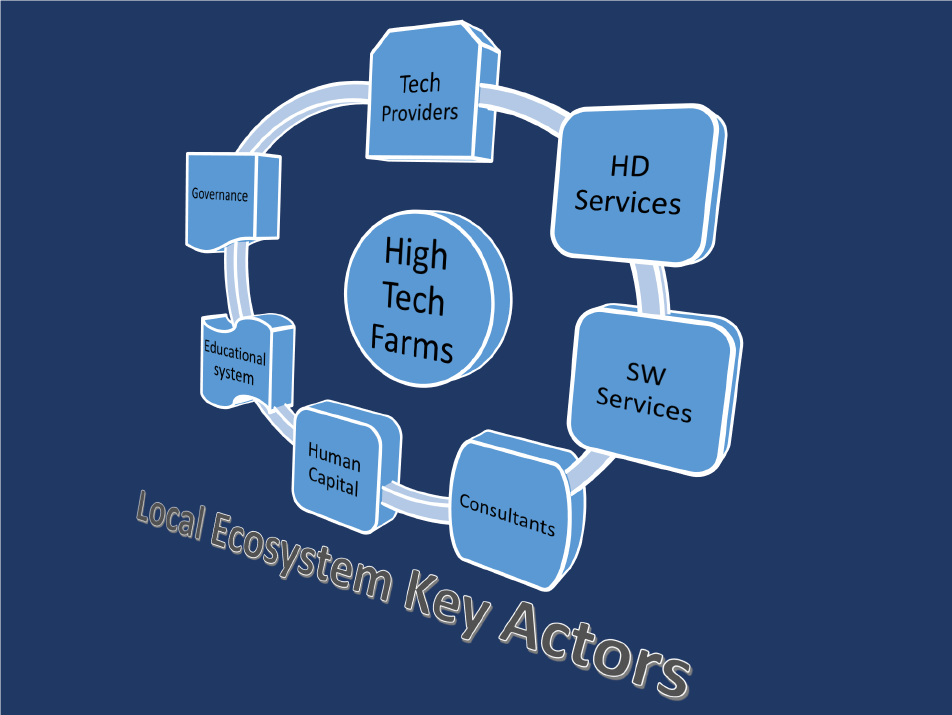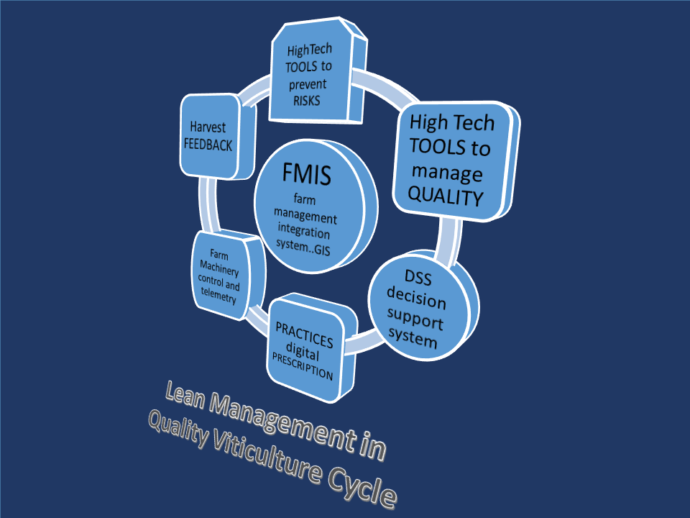The proper introduction of High Tech Farming (HTF) in the farming process and in the related agri-businesses requires a particular attention and it can be summarized in 3 essential steps:
A. the integration and compatibility of the introduced technologies in the production process
B. the choice of an appropriate technology, in terms of type and dimension, for the business model analysis
C. the evaluation of the local ecosystem which supports the profitable introduction of a new technology in the farming process (key factors and key actors).
A. It is important to clearly define the position of the introduced technologies in the farming production process (practice flow). The objective is the opportunity to check compatibility, interoperability and synergy with other blocks of the flowchart. In the case of vineyard growing, which is an open field production activity, 8 macro-blocks can be defined in the flowchart process:
- process management tools such as FMIS (Farm Integration Management System) -GIS, with layers of spatial knowledge of the field and product (soil, water, crop, diseases, fruit quality); it should always be updated with the following factors;
- control and risk management tools for crops [frost, pests, water stress];
- quality monitoring management tools through the creation of soil, crop, fruit, and microclimate maps;
- DecisionSupportSystem(DSS) on risks control and quality factors management;
- farming prescription maps;
- machinery fleet control;
- automation and robotization of machinery;
- harvest feedback (spatial quality and quantity)
B. The choice of an appropriate technology, in terms of type and dimension, for the business model analysis (ERP Enterprise Resource Planning or BM business Model). Hoes and satellites have the same level of importance in the different farming scenarios. Since type and dimension of technologies have the same importance in the production process and in farming, they should be adopted choosing the proper solution.
C. the evaluation of the local ecosystem which supports the profitable introduction of a new technology in the farming process (key factors and key actors). The performances of the introduced technologies depend on an appropriate support at local and enterprise level: any technology requires providers and services to be maintained, repaired and set up, which means well-trained consultants and human capital. For example, in the “trial period” of a chosen technology, in the so-called “use cases”, the KPIs (Key Performance Indicators) are affected by a particular care of providers, services and researchers. But which are the conditions to maintain the same performance after the “trial period”, when the entrepreneur is not on the spot? The pertinence of all key actors should be assessed by the introduction of new technologies. Consequently, it is important to define the minimum readiness level (MRL) composed by provider readiness level (PRL), Service hardware Readiness Level (ShdRL), Hardware Services for the new technologies, Service software readiness level (SswRL), Softwares Services for the new technologies, Consultant readiness level (CRL), Consultants for the new technologies, Human Readiness Level (HRL), Human capital for use new technologies, Farming Readiness Level (FRL), Farming system introducing new technologies. The efficiency of the local ecosystem, which supports the introduced technologies, is determined by the growth of skills and competence level (as the Readiness Level in the Technologies) of all key actors; each single actor is responsible for maintaining or dropping the efficiency of the whole system. In this way, it could be also possible to define the Local Ecosystem Readiness Level (LERL) required by the new technology

